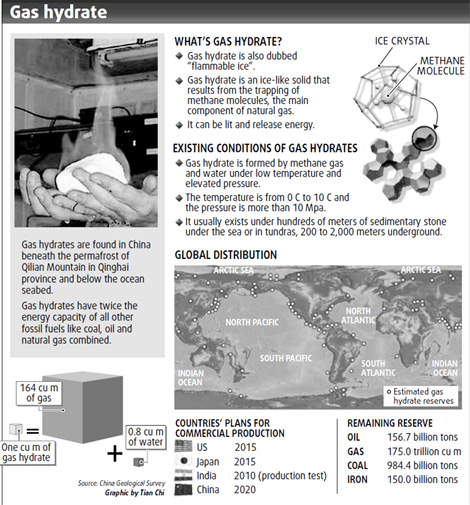
|
CHINA> National
 |
|
Flammable ice a hot prospect for future energy
By Wang Qian (China Daily)
Updated: 2009-10-30 08:23 Scientists predict China will become one of the first countries to begin production of gas hydrates, an enormous untapped energy source. Production of gas hydrates, also known as flammable ice, will begin in China's tundras around 2020 and underwater after 2030, scientists predicted. "In the next decade, scientists will probe the reserves of gas hydrates," said Zhang Hongtao, chief geologist with the Ministry of Land and Resources. Analysts believe that by 2020, nearly 65 percent of the oil consumed in China will have to be imported.
Not only China, but countries all over the world are taking strides to put commercial production of gas hydrates into reality before the earth's supply of oil is used up, he added. Scientists believe there are about 156 billion tons of oil reserves, enough to last for 41 years. Global reserves of natural gas are estimated to be 175 trillion cu m, enough for 67 years. The size of the global gas hydrate reserve is about 21,000 trillion cu m, and holds twice the energy capacity of all other fossil fuels like coal, oil and natural gas combined, said Zhang Haiqi, chief scientist of the China Geological Survey. Flammable ice is almost pure methane mixed with water and frozen under high pressure in permafrost or under the sea. One cu m of gas hydrate could release at least 164 cu m of methane. "With its huge energy potential, countries all over the world are speeding up their preparations for commercial production of gas hydrate, but we are not in a big rush until its environmental impacts are clear," Zhang said. Gas hydrates, as an energy resource, may play important roles in the global carbon cycle, he said. Methane, which is 10 times more damaging than carbon dioxide, will cause the earth's temperature to increase, raising sea levels and speeding up climate change. No country has been able to produce the resource commercially due to the challenging conditions of the gas hydrate and the unpredictable environmental impact. So far, China does not have a specific commercial exploration plan, Zhang said. Energy experts told Wenweipo earlier this month that the government will invest more than 1 billion yuan to accelerate its exploration and realize commercial production in tundras around 2030. China started gas hydrate research in the late 1990s. On May 1, 2007, the country collected its first gas hydrate samples in the South China Sea, becoming the world's fourth country to confirm its findings under water after the United States, Japan and India. Analysis showed there are about 16 billion cu m of gas hydrate in the area. Last month, China confirmed the existence of the resource in Qilian Mountain in Qinghai province, becoming the world's third country to confirm its finding in tundras after the US and Canada. The estimated potential gas hydrate in China's permafrost is about the equivalent of more than 35 billion tons of oil. Gas hydrates have been found in nearly 80 countries and regions and more than 30 countries have begun searching underwater for the resource, with the US and Japan leading the world's marine expedition for gas hydrates. China has pledged more investment in developing alternative energy resources, including biomass fuel, liquefied coal and flammable ice.
 |
|||||||